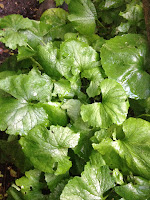 As foodies know, what with NOMA and everything, foraging is
all the rage. But can you actually forage food in the city, in a borough like
Islington which is known for a shortage of green space? Apparently you can. I
doubt very much whether you could survive by foraging alone and actually live off the
fat of the land so to speak, but there is edible stuff out there, in the cracks
of pavements (although with the number of dogs around, foraging on pavements
might not be for me), in housing estates, parks, and community gardens. Wilderness
centres such as Gillespie Park and community gardens such as the Olden Garden
on Whistler Street, and King Henry’s Walk Garden in the Mildmay area are filled
with berries and edible flowers and plants. Plants such as Dandelion and
Elderflower, and many forms of cress, are found in abundance wherever you care
to look.
As foodies know, what with NOMA and everything, foraging is
all the rage. But can you actually forage food in the city, in a borough like
Islington which is known for a shortage of green space? Apparently you can. I
doubt very much whether you could survive by foraging alone and actually live off the
fat of the land so to speak, but there is edible stuff out there, in the cracks
of pavements (although with the number of dogs around, foraging on pavements
might not be for me), in housing estates, parks, and community gardens. Wilderness
centres such as Gillespie Park and community gardens such as the Olden Garden
on Whistler Street, and King Henry’s Walk Garden in the Mildmay area are filled
with berries and edible flowers and plants. Plants such as Dandelion and
Elderflower, and many forms of cress, are found in abundance wherever you care
to look.  I recently attended a guided talk on foraging at the
hidden-away gem King Henry’s Walk Garden, given by Bob Gilbert, author of 'The Green London Way'. He
identified many plants, generally discarded as weeds, which can be eaten.
Whether you would actually want to is another matter and one I have yet to put
to the test, but one or two were certainly very interesting. The common nettle
can apparently be cooked like spinach (dock leaves too) and used to replace
hops as a bittering agent in brewing. The blue flower of the Alkanet – known as
“poor man’s henna” - can be used to decorate salads, as can a dog violet. The
dandelion can be used in many ways – the leaves as a bitter addition to a
salad, the flowers to make wine, and the roots can be dried and made into a
coffee substitute, which by all accounts is revolting, so it's not clear why
anyone would bother. Sloes can of course be made into Sloe Gin (although I
prefer it straight myself). Wild herbs and forms of mint, including wild
water-mint in ponds, are also abundant.
I recently attended a guided talk on foraging at the
hidden-away gem King Henry’s Walk Garden, given by Bob Gilbert, author of 'The Green London Way'. He
identified many plants, generally discarded as weeds, which can be eaten.
Whether you would actually want to is another matter and one I have yet to put
to the test, but one or two were certainly very interesting. The common nettle
can apparently be cooked like spinach (dock leaves too) and used to replace
hops as a bittering agent in brewing. The blue flower of the Alkanet – known as
“poor man’s henna” - can be used to decorate salads, as can a dog violet. The
dandelion can be used in many ways – the leaves as a bitter addition to a
salad, the flowers to make wine, and the roots can be dried and made into a
coffee substitute, which by all accounts is revolting, so it's not clear why
anyone would bother. Sloes can of course be made into Sloe Gin (although I
prefer it straight myself). Wild herbs and forms of mint, including wild
water-mint in ponds, are also abundant. 
By far the most intruiging identification from a foodie perspective
was ‘Jack By The Hedge’, or garlic mustard, a wild leaf with a very distinctive
aroma and flavour of garlic (pictured right). I have since discovered that the internet is, predictably enough, full of recipes making use of this plant.
The next step for the budding forager will be to actually produce something from
locally foraged material – and when I get there I will post more. This little post
is just a few thoughts and musings on what is possible.UPDATE 16/07/12: Anna Colquhoun has kindly pointed out that as Gillespie Park is on contaminated land it is inadvisable to pick leaves there, but berries should be fine. Anna is the author of Eat Slow Britain and runs Nordic cookery classes in Highbury, bookable via her website http://www.culinaryanthropologist.org.

King Henry's Walk Garden
11c King Henry's Walk
London N1 4NX
No comments:
Post a Comment